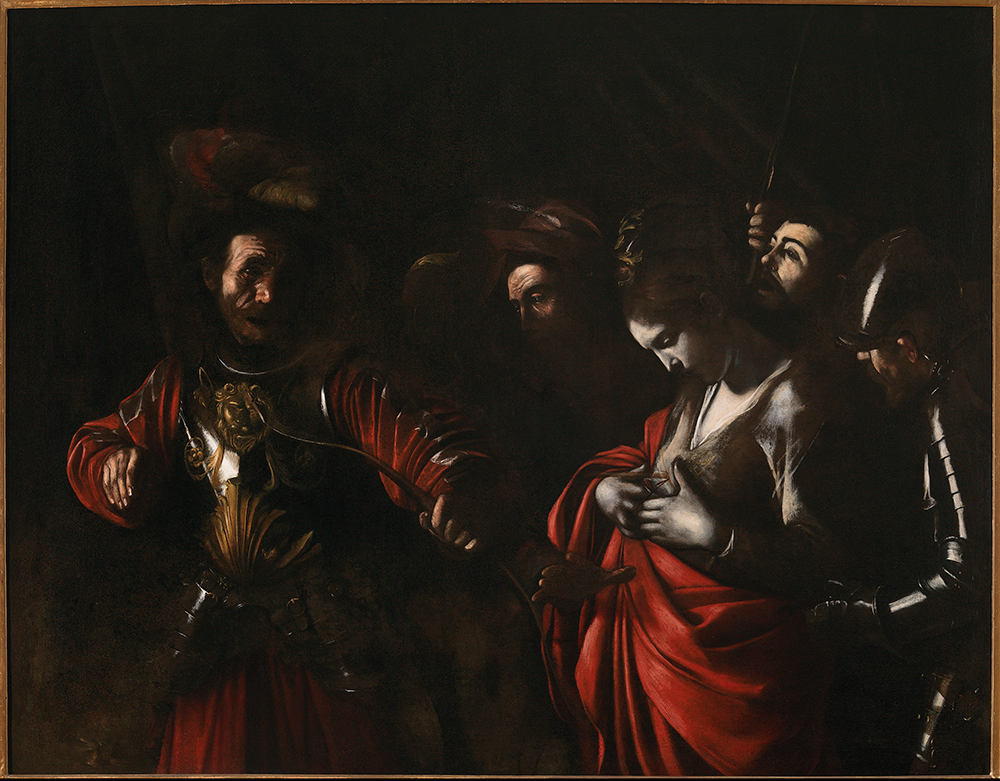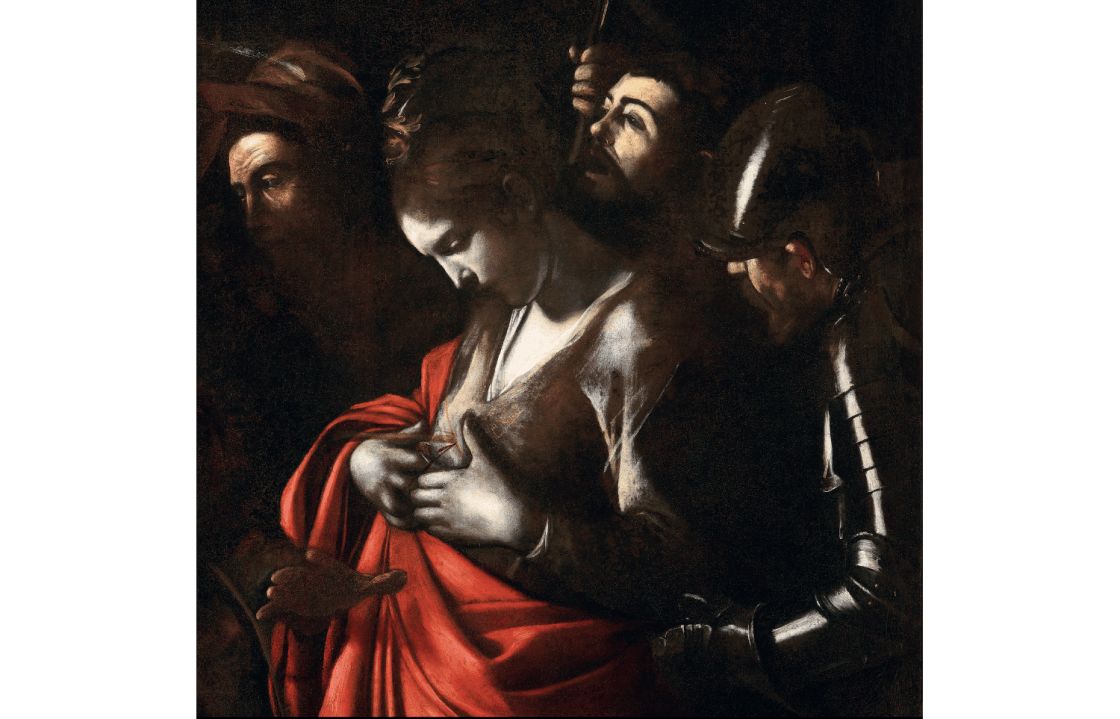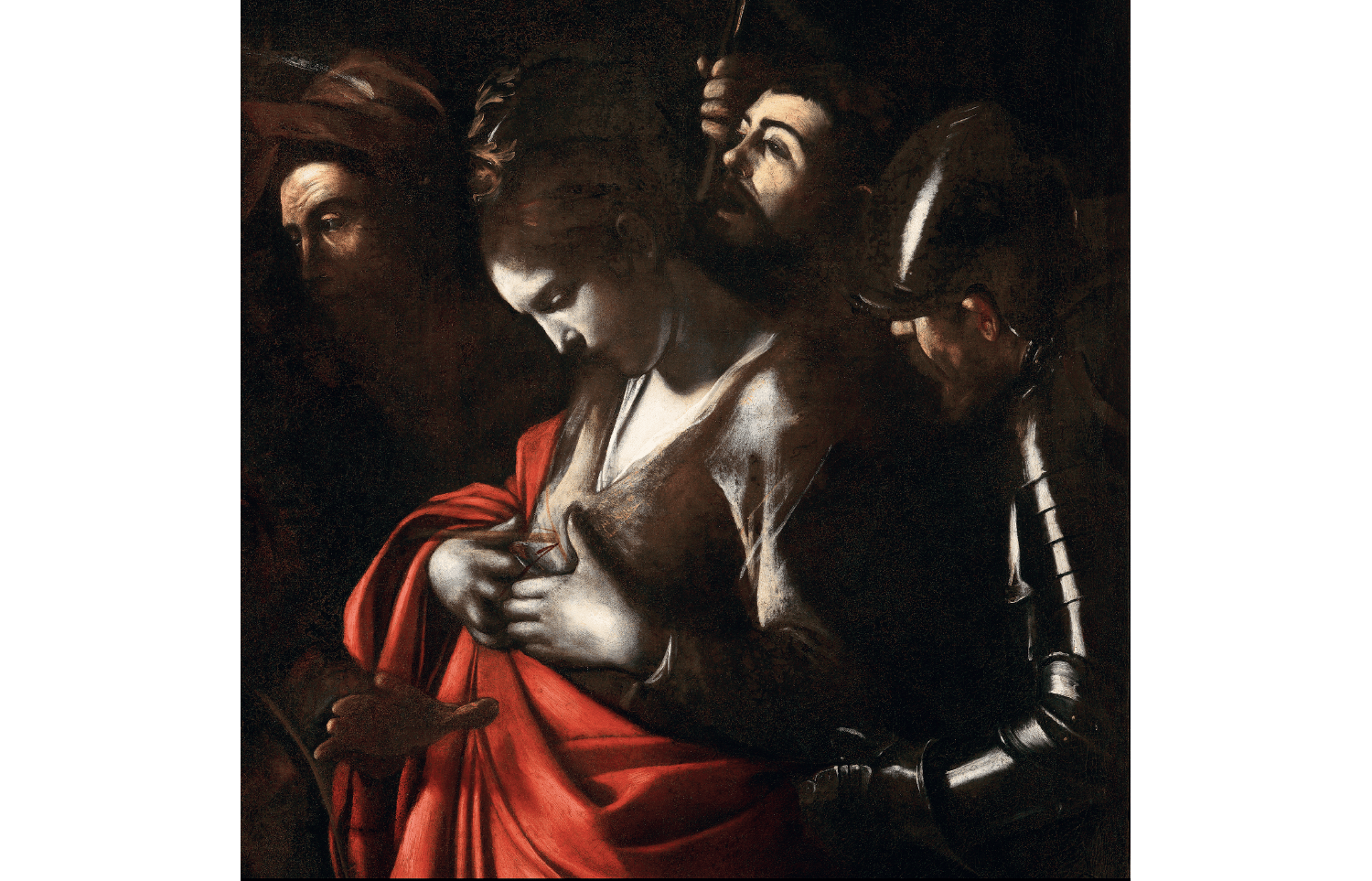Laura Gascoigne has narrated this article for you to listen to.
For centuries no one knew who it was by or even what it was of. The picture that had hung unnoticed in a succession of noble palazzi in the Italian province of Salerno, with its deep chiaroscuro and close-cropped composition, looked like a Caravaggio – but after Caravaggio almost every painting in Naples did.
When it entered the collection of the Banca Commerciale Italiana in 1973 it was attributed to Mattia Preti, a Calabrian Caravaggista of the next generation who had caught the tenebrist bug. But in 1980, a letter discovered in the Naples State Archive changed the picture. Written on 11 May 1610 by Lanfranco Massa – the Naples agent of the Genoese nobleman Marcantonio Doria – it explained a delay in the transportation of a painting of Saint Ursula to Genoa. Massa had left it out in the sun to dry more quickly and the varnish had gone soft ‘because Caravaggio puts it on very thick’. He was going to talk to the artist about it.
This is how violence looks up close, as Caravaggio knew
Why the hurry? Caravaggio was preparing to leave Naples, the city which had been his refuge, on and off, since his flight from Rome on a murder rap four years earlier. A rumble on a tennis court in May 1606 with local pimp Ranuccio Tomassoni – reportedly over a bet or a woman – had begun with tennis rackets and escalated to swords, and Tomassoni had been fatally wounded. His Roman patrons were prepared to forgive the artistic genius with the cervello stravolto – the deranged brain – a multitude of sins, but this time he had gone too far. He left Rome with a price on his head – a bando capitale entitling anyone in the Papal States to perform a citizen’s execution and produce his head in evidence – and fled south to the Spanish-ruled Kingdom of Naples.
Described by Cervantes as ‘the richest and most depraved city in the whole world’, Naples was then, as now, very different from Rome. It was three times bigger, with a population of 300,000 crowded into its warren of narrow streets, ‘all of them full of people on foot, on horseback, in carriages’, in the words of a contemporary guide to the city. Not much has changed: replace the carriages with Fiats and the horses with Vespas and he could have been describing Naples today.
For an artist on the run it was the perfect bolthole, rich in wealthy patrons and in the middle of a Baroque church-building boom that reached from the historic centre to the Rione Sanita, where a new basilica to the Virgin had been designed by the Dominican architect Fra Nuvolo. In Rome Caravaggio had struggled to win church commissions; here they fell into his lap. Who better than the celebrity artist to paint ‘The Seven Acts of Mercy’ (1607) for the high altar of the Pio Monte della Misericordia, the new church built by a charitable confraternity of young do-gooders in the Via dei Tribunali? The dramatic night-time composition Caravaggio produced, with all seven acts squeezed into a corner of a Neapolitan street and a cast of local characters, a Virgin and angels fluttering like pigeons between the rooftops, announced his arrival.
This astonishing work, which inspired the closing scene in John Steinbeck’s The Grapes of Wrath with its shocking image of a young woman breast-feeding a starving old man, is one of only three paintings by Caravaggio still in Neapolitan hands. ‘The Flagellation of Christ’ (1607) painted for San Domenico Maggiore, is in the collection of the Capodimonte Museum (currently on display in the Diocesan Museum). But ‘The Martyrdom of Saint Ursula’ (1610), which normally hangs in the Banca Intesa Sanpaolo’s Gallerie d’Italia, has come to London’s National Gallery for a free display, The Last Caravaggio, joined by the gallery’s ‘Salome receives the Head of John the Baptist’ (c. 1609-10) and Massa’s manuscript letter.

Unlike ‘The Seven Acts’, ‘Saint Ursula’ was a private commission chosen to mark the entry of Doria’s stepdaughter into a Naples convent and her taking the name Sister Ursula. According to medieval legend, Ursula was a Breton or British Christian princess who made it a precondition of her marriage to the Anglian Prince Ethereus that he grant her three years’ grace to make a pilgrimage to Rome with an escort of maidens-in-waiting (11,000, by some inflated accounts). On their return via Cologne, the pilgrims had the misfortune to run across a horde of marauding Huns. Struck by Ursula’s beauty, their leader offered to spare the women’s lives if she married him; on her refusal a massacre ensued.
Earlier artists had used the story as an excuse for painting a bevy of virginal beauties under Ursula’s protection or a killing field littered with female corpses and severed heads. Caravaggio had nothing against painting severed heads – witness his John the Baptist, Goliath and Holofernes – but crowd scenes were not his thing. An early adopter of the Robert Capa principle ‘If your pictures aren’t good enough, you’re not close enough’, he posed his protagonists steps away from each other, so close that his Ursula can hardly have seen the arrow coming before closing her hands on its shaft as it penetrates her chest. Her head is inclined at the angle of Leda’s in Michelangelo’s ‘Leda and the Swan’ and her expression is rapt: she has taken a mortal hit for her Christian God.
All eyes are fixed on the couple, but they’re not alone. Other figures lurk in the background shadow, barely visible through the murk: one thrusts a foreshortened hand between the archer and his target, too late to intervene, while a soldier lays a gauntleted hand on Ursula’s arm, juxtaposing the flash of steel with flesh. Behind the soldier the artist has painted his self-portrait, head tilted as if craning for a better view.
Seeing the painting in the Gallerie d’Italia surrounded by works by Caravaggio’s followers, you can understand how it might have been mistaken for a Preti. It lacks the surface polish one expects from a Caravaggio, although that could be the fault of Massa’s fast-drying method. But seeing it beside the National Gallery’s ‘Salome’, also from the end of his second stay in Naples after short breaks in Malta and Sicily, the parallels are obvious. ‘You come upon the scene midway and you’re immersed in it,’ Martin Scorsese observed about the painter he credits with inspiring his shooting of Mean Streets. This is how violence looks up close, as Caravaggio knew. It’s this, as much as the one-directional lighting, that makes his work feel cinematographic.
Is ‘The Martyrdom of Saint Ursula’ the last Caravaggio? There are other contenders for that title, not least the Galleria Borghese’s ‘David with the Head of Goliath’ (c.1605-10) with its grisly self-portrait painted for Cardinal Scipione Borghese in the hopes that he would swing a papal pardon from his uncle Paul V and stop the artist’s decapitation becoming a reality. ‘Saint Ursula’ is the last Caravaggio to be rediscovered, but there may be others out there: ‘Salome’ was only identified in a Swiss private collection in 1959.
When a painter has so many imitators, his work can easily get lost among them. Even while he was recovering from another rumble in a Naples tavern that left him almost unrecognisable, Caravaggio’s last months in Naples were extremely productive: three paintings of that period – a ‘Resurrection’, a ‘Saint John’ and a ‘Saint Francis’ for Sant’Anna dei Lombardi – are unaccounted for. There’s also the record of a hundred ducat payment towards a ‘Circumcision’ altarpiece for Santa Maria della Sanità due for completion in 1612. The version of the subject now in place is by one of Caravaggio’s army of imitators, Giovanni Vincenzo Forli, but X-radiography of the paint surface has revealed a tell-tale grimace on the face of the girl with the basket of fruit squeamishly witnessing the operation. Had he hung around long enough to finish it, this might have been the last Caravaggio.
A banner outside the church today boasts: E meraviglioso essere Napoletano – ‘It’s marvellous to be Neapolitan’. Caravaggio didn’t think so; in expectation of a papal pardon, he couldn’t wait to get back to Rome. But trouble dogged his footsteps. When the felucca he boarded in July stopped off in the tiny port of Palo, he was arrested by the captain of the local fortress in what seems to have been a case of mistaken identity; with his scarred face he must have looked like a villain. By the time he bought the captain off, the felucca had sailed with all his belongings and three paintings aboard, ‘Salome’ possibly among them. In desperation he tracked the boat through the midsummer heat, 70 miles up the mosquito-ridden coast to Porto Ercole, where he succumbed to a fever, probably malaria, aged 38. ‘And so,’ wrote his biographer Giovanni Baglione, ‘without the aid of God or man, in a few days he died, as miserably as he had lived’ – leaving behind a body of work that feels more alive than that of any other painter in history.
The Last Caravaggio is at the National Gallery from 18 April until 21 July.








Comments